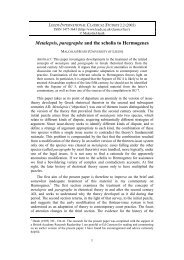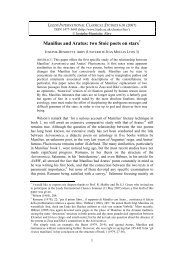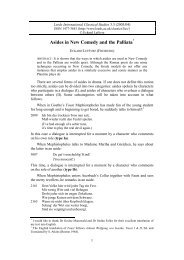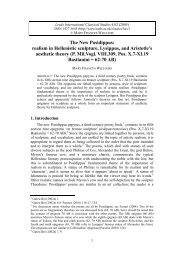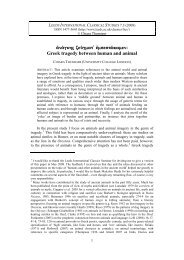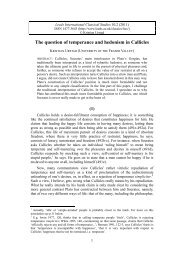Revisiting Tarpeia's myth in Propertius (IV, 4) - Leeds International ...
Revisiting Tarpeia's myth in Propertius (IV, 4) - Leeds International ...
Revisiting Tarpeia's myth in Propertius (IV, 4) - Leeds International ...
You also want an ePaper? Increase the reach of your titles
YUMPU automatically turns print PDFs into web optimized ePapers that Google loves.
MYRTO GARANI, REVISITING TARPEIA’S MYTH IN PROPERTIUS (<strong>IV</strong>, 4)<br />
saeuit <strong>in</strong>ops animi totamque <strong>in</strong>censa per urbem 300<br />
bacchatur, qualis commotis excita sacris<br />
Thyias, ubi audito stimulant trieterica Baccho<br />
orgia nocturnusque uocat clamore Cithaeron.<br />
Helpless <strong>in</strong> m<strong>in</strong>d she rages, and all aflame raves through the city, like some<br />
Thyiad startled by the shaken emblems, when she has heard the Bacchic cry: the<br />
biennial revels fire her and at night Cithaeron summons her with its d<strong>in</strong>.<br />
Dido herself is compared with a Bacchanal wildly revell<strong>in</strong>g on Mount Cithaeron<br />
<strong>in</strong> Boeotia <strong>in</strong> honour of the god Bacchus. From this moment on, Dido beg<strong>in</strong>s to<br />
lose control over her actions. This lunatic behaviour will eventually br<strong>in</strong>g about<br />
her destruction. Yet Dido’s fate has also been foreshadowed by her implicit<br />
comparison with the Amazon Penthesilea <strong>in</strong> the first book of the Aeneid (Aen.<br />
1.490-2): 27<br />
Ducit Amazonidum lunatis agm<strong>in</strong>a peltis 490<br />
Penthesilea furens mediisque <strong>in</strong> milibus ardet,<br />
aurea subnectens exsertae c<strong>in</strong>gula mammae,<br />
bellatrix, audetque viris concurrere virgo.<br />
Penthesilea <strong>in</strong> fury leads the crescent-shielded ranks of the Amazons and blazes<br />
amid her thousands; a golden belt she b<strong>in</strong>ds below her naked breast, and, as a<br />
warrior queen, dares battle, a maid clash<strong>in</strong>g with men.<br />
Penthesilea is the last figure that Aeneas sees on the frieze that decorates the walls<br />
of the temple of Juno when he arrives at Carthage. She is also the last figure seen<br />
before Dido’s appearance. Instead of Tarpeia’s Vesta, it is Venus who <strong>in</strong>structs the<br />
disguised Cupid to breathe love <strong>in</strong>to Dido.<br />
Tarpeia simultaneously harks back to another Vergilian character, Amata. 28<br />
This time Juno calls on Allecto, the Vergilian agent of fury and discord, to sow the<br />
seeds of war (cf. Aen. 7.325-6: cui tristia bella / iraeque <strong>in</strong>sidiaeque et crim<strong>in</strong>a<br />
noxia cordi / whose heart is set on gloomy wars, passions, plots, and baneful<br />
crimes). Allecto picks up one of her snakes and hurls it at Amata (Aen. 7.347).<br />
Like Tarpeia, who is unaware of the assault of the new demons (nescia se furiis<br />
accubuisse novis, <strong>IV</strong>.4.68), Amata herself does not realize that the goddess’ snake<br />
<strong>in</strong>jects poison deep <strong>in</strong>side her and <strong>in</strong>flames her (ille <strong>in</strong>ter vestis et levia pectora<br />
lapsus / voluitur attactu nullo, fallitque furentem / vipeream <strong>in</strong>spirans animam /<br />
Glid<strong>in</strong>g between her raiment and smooth breasts, it w<strong>in</strong>ds its way unfelt and,<br />
unseen by the frenzied woman, breathes <strong>in</strong>to her its viperous breath, Aen. 7.349-<br />
51). Amata, like Dido and Tarpeia, is also compared to a Maenad (Aen. 7.385-91,<br />
404-5):<br />
qu<strong>in</strong> etiam <strong>in</strong> silvas, simulato num<strong>in</strong>e Bacchi 385<br />
maius adorta nefas maioremque orsa furorem<br />
evolat et natam frondosis montibus abdit,<br />
quo thalamum eripiat Teucris taedasque moretur,<br />
27<br />
For parallels between Dido and Penthesilea see Segal (1990) especially 3-7; Putnam (1998) 255-<br />
62.<br />
28<br />
Warden (1978) 186 with further bibliography. See also Rothste<strong>in</strong> (1898) ad loc.; D’Arbela<br />
(1964) ad loc.; He<strong>in</strong>ze (1993) 280 n.52.<br />
7



